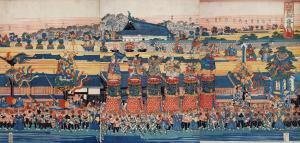Illustration of the Sanno Festival (Sanno Gosairei-zu)
Painted by Utagawa Kuniteru Around 1830-1844 (Tempō Period) Tokyo Shiryō Collection 331-C6
The "Sanno Festival", held welcome the onset of summer in Edo first started in the early Edo period. Sanno refers to the Hie Shrine, which was maintained with great care as the protective shrine of the Shogunate family and Edo castle. This festival attracted a large number of visitors and was recognized as a Tenka Matsuri, which means it was held with the official approval of the Shogunate.
This is a series of three color prints depicting the scene of a magnificent procession of dashi (festival floats) in the Sanno Festival. There are separate lines of dashi and mikoshi (palanquin) and at the time dashi were the main focus and every neighborhood would prepare dolls and decorations based in principle on the established motif. At the beginning of the procession was a kankodori (cuckoo-the symbol of peace as a result of good politics) of Otenma-cho and a monkey of Minami Denma-cho that carried Gohei, a messenger of the Sanno Gongen Shrine, came in the second, and these two symbols were fixed every year while the rest of neighborhoods differed more or less depending on the year. For example, at the Kanda Festival called the Whole Country Festival, a kankodori similarly came first and a monkey in the second, but the colors of cuckoo and Gohei were different from those at the Sanno Festival.
the Sanno Gongen has been long established and when Dokan Ota built a castle in Edo, he called upon the Sanno Shrine in Kawagoe as the deity to protect the nation from rebellion and then after, as Ieyasu Tokugawa made the Sanno Gongen the tutelary deity of the castle, its festival, the Sanno Festival, also became the Whole Country Festival.
Although the Sanno Festival and the Kanda Festival reached the height of extravagance as the two of the Great Edo Festivals, they were held in alternate years from 1681 in order to alleviate the parishioners' burden.


